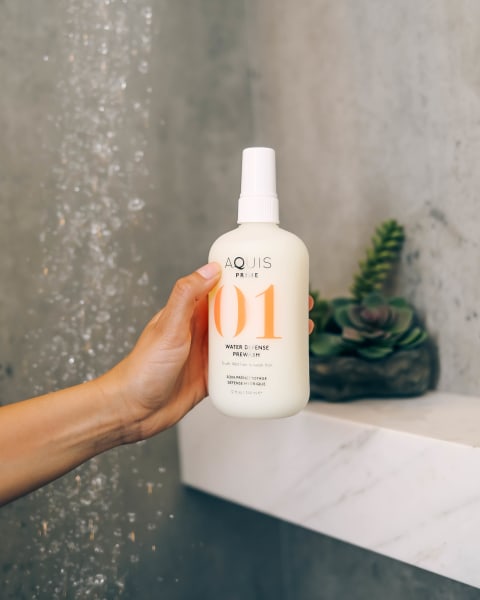Advertisement

It's not just split ends—between the blowout bars, regular dye jobs, and endless styling products on rotation, it's not so much a question of if your hair is damaged but instead how badly.
The only real cure for hair damage is taking steps to prevent new damage from happening. Read on for five research-backed adjustments you can make in your haircare routine today to help restore health to your stands and keep those good hair days coming.
Rethink your rinse cycle.
If you're washing your hair on the daily, rule No. 1 is to do so less often. Overwashing can be damaging for hair, especially if your hair is bleached, colored, or chemically treated. While different hair types have different needs, most haircare experts agree that shampooing only a few times a week is ideal. And it's not just because conventional shampoos can strip your hair and scalp of its oils, cause buildup, and throw its natural pH off balance: Hair is most vulnerable to damage and breakage when it's wet—period.
From the moment it gets wet, hair strands absorb water into its cortex, stretching and swelling the longer hair stays drenched. This causes the outer cuticle to lift and open (letting in even more water), and as hair dries, the cuticle is prone to crack, break, or stay lifted. If you have untamable frizz, or hair that feels rough to the touch, you can blame lifted cuticles from water absorption.
Which brings us to rule No. 2: Wash wisely. Prewashes (or pre-poos) are proof that we're getting smarter about our haircare routines. These typically oil-based treatments act as a nourishing first step in making hair hydrophobic, protecting and preventing strands from damaging water absorption.
The coconut-oil-based Prime Water Defense Prewash by Aquis can reduce hair swelling by a whole 46% with just a few spritzes two minutes before your shower. And paired with a sulfate-free, non-stripping shampoo like Aquis' Prime Rebalancing Hair Wash, which helps keep the cuticle smooth, rethinking your shower routine will go a long way in improving the look and feel of your hair.

Brush up on your detangling skills.
We'll admit, brushing our hair might feel like the closest thing to an instant makeover, and it's probably the most intuitive haircare step of all. Just brush, right? The truth is, there's definitely a right and wrong way to do it. For starters, save your brush for dry hair (and keep the habit to once a day). If you must brush wet hair, use a wide-tooth comb, which can glide through wet hair much more gently and minimize snagging, especially if your hair is wavy or curly.
Whether wet or dry, never start at the root and pull hair down to the ends. Doing so can stretch and pull strands out of the follicle, as well as chip the cuticle, resulting in hair breakage1. Instead, using short strokes, start a few inches from the bottom and slowly work your way up your hair in small sections.
Cool it on the hot tools (and always wear protection).
For obvious reasons, heat is not a friend of healthy hair2. The main thing to remember when blow drying, curling, or straightening hair with high temperatures is 1) keep it off the hottest setting, and 2) keep the tool moving. If a heat protectant isn't already in your arsenal, now's the time to stock up. And even better: If you can skip the heat styling altogether and give your hair a break, do it.
But what's not so obvious is that air drying your hair can be even more damaging than using a hair dryer safely (that's not a typo). Studies have found that while using a hair dryer can cause more surface damage than drying naturally, a continually moving hair dryer aimed 5 inches away actually causes less damage2 to the hair's cell membrane than air drying. This just goes to show how damaging waterlogged hair can be if left wet.
Thankfully, it's possible to cut towel-drying time in half—and even avoid roughing up the cuticle even further—with soft, water-wicking hair towels and turbans like the Rapid Dry Hair Turban from Aquis, which is available in their hair-fortifying starter kit.

Don't forget your scalp!
Healthy hair starts at the hair follicle, and a healthy scalp can make all the difference in growing healthy hair3. Studies have shown that a daily scalp massage4 can stimulate hair follicles and increase hair growth and even thickness. Most of us won't need a reminder to give ourselves a little massage daily, but an easy way to make it habitual is to massage your scalp while you wash your hair. Need a quick tutorial on how to do one? We got you.
Or your hairdresser.
This one is easy because all it involves is making an appointment for a trim, then sitting back and relaxing. All experts agree that getting regular haircuts (every six to eight weeks) helps ensure minimal split ends and breakage. So while it'll take time and a few routine tweaks to fully revive dry, weakened, and frizzy hair, don't underestimate the power of a pair of shears.
